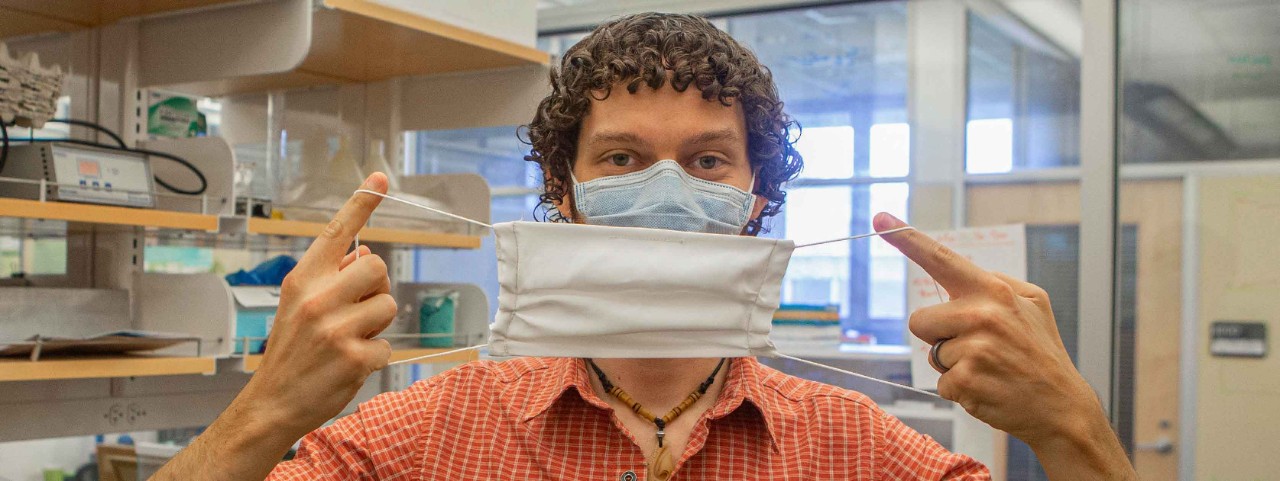
Silk layer improves function of surgical masks
A double layer of silk improves the function and extends the lifespan of surgical masks
University of Cincinnati researchers found that a double layer of silk in combination with a surgical mask can enhance its ability to prevent the spread of viruses like COVID-19.
UC biologist Patrick Guerra, UC biologist Theresa Culley, UC postdoctoral researcher Adam Parlin, now at SUNY-ESF, and UC graduate student Samuel Stratton, now at the University of Michigan, began investigating silk as an alternative face mask material at the start of the COVID-19 pandemic in 2020 when personal protective equipment such as the N95 face mask was in short supply.
UC researchers found that double masking with a silk face mask also helps prolong the life of surgical masks without impeding a person's ability to breathe comfortably.
The study was published in the journal Aerosol and Air Quality Research.

UC researchers studied the effectiveness of surgical masks in combination with a silk face mask. Biology student Adam Parlin, now with SUNY-ESF, examined the properties of silk in a UC biology lab. Photo/Joseph Fuqua II/UC Creative + Brand
The study was a collaboration between UC biologists and Sergey Grinshpun, Mikhail Yermakov and Susan Reutman in the Center for Health-Related Aerosol Studies in UC's College of Medicine.
“People are still using surgical masks to protect others and themselves. But they can be loose at the sides and around the nose,” said Guerra, an assistant professor of biology in UC’s College of Arts and Sciences.
Guerra and his colleagues collaborated with researchers with the UC College of Medicine’s Center for Health-Related Aerosol Studies.
As cases of COVID-19 begin to increase across the United States, more people are reaching for masks again to protect themselves and those around them.
“At the time of our study, personal protective equipment was at a premium in terms of availability because of supply-chain issues,” Guerra said. “People were having to reuse their masks.”
Masks are becoming a growing source of litter around the world.
“They take a long, long time to degrade,” Guerra said.
So taking full advantage of each mask’s useful lifespan can help prevent waste, he said.
Guerra studies the amazing properties of silk in his biology lab. Silk fiber has antimicrobial properties. And silk is hydrophobic, which means it sheds water unlike cotton masks that typically absorb it.
And silk is far more breathable than cotton.
“We showed that a silk mask doesn’t increase the burden of breathing when used in a double layer with a surgical mask. It wasn’t uncomfortable,” Guerra said. “And it enhances the ability of surgical masks to do their job.”
The research was supported by grants from the National Institute for Occupational Safety and Health and UC's Education and Research Center.
Featured image at top: UC student Adam Parlin holds up a silk face mask in a biology lab. Photo/Joseph Fuqua II/UC Creative + Brand
UC researchers tackle COVID-19

Researchers across UC's colleges are tackling issues relating to the COVID-19 pandemic. Photo/Volodymyr Hryshchenko/Unsplash
Impact Lives Here
The University of Cincinnati is leading public urban universities into a new era of innovation and impact. Our faculty, staff and students are saving lives, changing outcomes and bending the future in our city's direction. Next Lives Here.
Related Stories
Chris Higgins named UC Foundation Vice President for Development, Academic Health Enterprise
January 6, 2026
The University of Cincinnati Foundation is pleased to welcome Chris Higgins as the new Vice President for Development, Academic Health Enterprise.
What's behind the mysterious rise of migraines?
January 5, 2026
Weather patterns such as extreme heat and storm conditions have been linked to migraine attacks, and research shows those environmental conditions are becoming more common. As National Geographic recently reported, one of the leading theories behind this mysterious rise is that climate change may be playing a role.
Top six 2025 nephrology drug approvals
January 5, 2026
“2025 has been a landmark year for kidney disease therapeutics, marked by a comprehensive slate of FDA approvals covering endothelin-receptor blockade, complement inhibition, GLP-1-based metabolic protection, and B-cell-directed therapy,” Prakash Gudsoorkar, MD, associate professor of clinical medicine at the University of Cincinnati College of Medicine and staff nephrologist at UC Health, recently told MedCentral.
